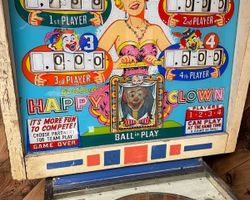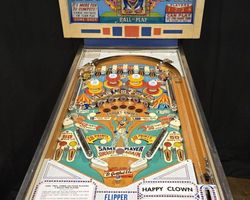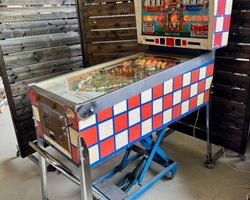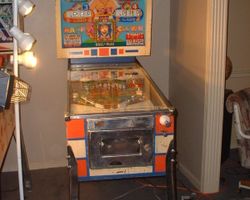Happy Clown
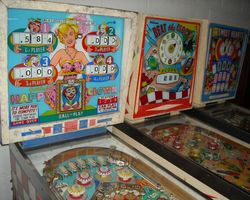
Average Prices: USD $200 to $1,100
Produced: November, 1964
Production Run: 3,235 units
Machine Type: Electro-mechanical
Players: 4
Design by: Wayne Neyens
Art by: Roy Parker
Gottlieb's "Happy Clown," released in November 1964, stands as a notable four-player electro-mechanical pinball machine from the era. With a production run totaling 3,235 units, split into two distinct batches—2,825 games in November 1964 and an additional 410 in February 1965—this machine, model number 214, embodies the design philosophies prevalent in the mid-1960s. The creative vision for "Happy Clown" was primarily driven by Wayne Neyens, who contributed to its overall design, conceptualization, mechanical engineering, and the distinctive backbox animation. The visual identity of the game, including its vibrant and at times divisive artwork, was the work of Roy Parker. The machine’s thematic foundation rests firmly within the circus and carnival realm, centered around a clown motif intended to convey a sense of lightheartedness and amusement.
One intriguing detail about "Happy Clown" involves a subtle production alteration. Early machines featured a ball shooter with a plastic beehive escutcheon, a common element in Gottlieb's earlier designs. However, later in the production cycle, this was replaced with a full metal plunger housing and a heavier-duty ball lift, a change that may coincide with the two recorded production runs. This distinction marks "Happy Clown" as potentially the final Gottlieb pinball game to incorporate the beehive escutcheon, offering a small yet significant marker in the company’s manufacturing evolution.
Distinctive Features and Design Philosophy
"Happy Clown" distinguishes itself through a suite of features that combine mechanical ingenuity with thematic presentation. The most prominent and frequently discussed element is the under-playfield projection roto-unit. This intricate mechanism projects target scores onto playfield inserts, with the roto-unit itself spinning beneath the surface. This mechanical marvel serves as a central focal point for scoring and adds a layer of anticipation as target values shift during gameplay. Its innovative nature was, for its time, a testament to the engineering capabilities of Gottlieb, offering a visual and interactive element beyond typical playfield components.
The backbox houses a mechanical animation that further reinforces the clown theme: an illuminated clown face bounces vertically whenever one-point scores are registered. This animation, while intended to be a charming visual reward, has garnered varied reactions, with some finding it a whimsical addition and others perceiving a disquieting quality in its movement. Roy Parker’s artwork on the playfield and backglass vividly portrays the circus theme, with clowns, circus tents, and other related imagery. The backglass also features a showgirl, adding to the carnival atmosphere. While some players find the artwork appealing and representative of its era, others find the clown motif less engaging or even unsettling. This divergence in aesthetic perception contributes to the machine's distinctive character.
Beyond these standout elements, the playfield is equipped with two flippers, four pop bumpers, and two slingshots, all standard elements for the period. Seven standup targets, notably spelling out "C-L-O-W-N," serve as critical objectives. Two kick-out holes and a stationary post positioned between the flippers contribute to the game's flow and challenge.
Playfield Dynamics and Mechanics
The playfield layout of "Happy Clown" is designed to create a challenging yet engaging experience, built around a relatively open lower playfield that transitions into a more dense upper area. Central to the scoring mechanics are the seven standup targets, specifically those forming the "C-L-O-W-N" sequence. These targets are strategically placed and often prove difficult to hit directly, frequently deflecting the ball back into the lower playfield. The four pop bumpers at the top of the playfield provide a bustling zone for higher-point scoring opportunities, as do the center rollovers situated just below the top arch.
The design philosophy behind "Happy Clown" encourages a specific style of play. A significant aspect of the game's flow involves an "upper vs. lower scenario." Players often find the ball gravitating towards the lower playfield, where opportunities for substantial scoring are more limited. Consequently, keeping the ball in the upper reaches of the playfield is crucial for maximizing points and advancing game objectives. This necessitates precise flipper control and, for many players, encourages a greater reliance on nudging the machine to guide the ball into advantageous positions rather than relying solely on flipper shots. The artwork on the playfield, executed by Roy Parker, integrates seamlessly with the mechanical features, with circus tent motifs, clown figures, and point value indicators that align with the under-playfield roto-unit's projections. Lighting is functional, illuminating targets and score inserts to guide player attention during gameplay.
Gameplay Progression and Strategic Depth
"Happy Clown" presents a gameplay experience centered on incremental scoring and a high-risk, high-reward multiplier system. The primary objective revolves around hitting the C-L-O-W-N standup targets. Completing this sequence activates or increases a multiplier on the roto-target scores, escalating up to a considerable 100x. A strategic element emerges from this system: players must decide whether to chase the C-L-O-W-N completion early for a high multiplier or save it for a later, high-scoring opportunity, as the multiplier often resets after being collected. Given the precise nature of the shots required, achieving the C-L-O-W-N sequence is often a test of player skill and patience.
Beyond the C-L-O-W-N targets, general scoring on "Happy Clown" can feel deliberate, with many targets and rollovers awarding points in small increments, such as 5 or 10 points. Engaging the pop bumpers at the top of the playfield is another avenue for accumulating points. Corner targets, when lit, also contribute to the score. The game also features a "Star" feature, which awards an extra ball. Due to the multiple projection windows on the under-playfield roto-target, securing an extra ball is often more attainable than on some other machines of the era.
"Happy Clown" is consistently characterized as a "tough" and "challenging" pinball machine. The smaller flippers make long, precise shots difficult, and the design often leads to short ball times, requiring quick reflexes rather than prolonged strategic contemplation. This difficulty, coupled with the need to keep the ball in the upper playfield, creates a demanding experience. However, the machine truly shines as a multiplayer game. While it can be a quick test of skill for a single player, its true competitive spirit emerges in four-player competition, where the high-stakes multiplier and demanding layout foster intense head-to-head battles, making it a source of enjoyment for groups.
Community Feedback and Enduring Relevance
"Happy Clown" evokes a broad spectrum of reactions from pinball enthusiasts, reflecting its distinct design and gameplay. A notable point of contention revolves around its aesthetic. While some appreciate Roy Parker’s artwork as a genuine representation of the 1960s circus theme, others find the clown imagery "creepy" or "awful," particularly the animated clown face in the backbox, which some describe as "disturbing." This stark divergence in perception underscores how personal artistic preferences can shape a machine's reception.
However, where "Happy Clown" consistently earns praise is for its mechanical innovation. The under-playfield projection roto-target is frequently highlighted as an "engineering feat" and an "innovative toy." This unique mechanism, which dynamically displays target scores, stands out as a clever design solution for the electro-mechanical era, captivating players with its novelty and contributing significantly to the machine's distinctiveness.
Gameplay feedback is equally varied. Many players find "Happy Clown" to be a "super fun" and "addictive" experience, especially in a multiplayer setting. Its challenging nature, with difficult-to-hit targets and a layout that demands precise ball control to keep it in the high-scoring upper playfield, appeals to those who seek a demanding game. The strategy of completing the C-L-O-W-N targets for multiplier activation adds a layer of depth that rewards skilled play. Conversely, some find the game's difficulty frustrating, citing short ball times and targets that too often deflect the ball into less advantageous areas. For single-player sessions, a segment of the community feels the game lacks sustained depth beyond the roto-target's primary mechanic, leading to a sense of repetition.
"Happy Clown" maintains a place in pinball history not just for its engaging, if challenging, gameplay, but also for its unique mechanical innovations. Its under-playfield roto-unit represents a creative solution for presenting dynamic scoring information, showcasing Gottlieb's willingness to experiment with novel mechanics during the electro-mechanical period. This innovation, while not widely replicated in subsequent machines, highlights a period of inventive exploration in pinball design. As a four-player EM machine from the mid-1960s, it offers a glimpse into the competitive social gaming experiences of the era, solidifying its reputation as a machine that continues to spark discussion and enjoyment among those who appreciate its particular blend of charm, challenge, and mechanical ingenuity.
Sponsored Links
 Ebay Listings
Ebay Listings
 Auction Results
Auction Results
| Cost | Location | Date |
|---|---|---|
| USD $410 |  Pennsylvania, United States Pennsylvania, United States |
16 August, 2025 |
| EUR €294 |  Hessen, Germany Hessen, Germany |
29 April, 2025 |
| USD $4,495 |  California, United States California, United States |
03 April, 2025 |
| EUR €1,200 |  Nordrhein-Westfalen, Germany Nordrhein-Westfalen, Germany |
07 February, 2025 |
| GBP £1,310 |  Ashfield, United Kingdom Ashfield, United Kingdom |
23 November, 2020 |
| USD $305 |  California, United States California, United States |
26 March, 2019 |
| USD $325 |  Ohio, United States Ohio, United States |
26 February, 2018 |
| EUR €1,350 |  Nordrhein-Westfalen, Germany Nordrhein-Westfalen, Germany |
26 December, 2017 |
| EUR €212 |  Nordrhein-Westfalen, Germany Nordrhein-Westfalen, Germany |
30 April, 2017 |
| USD $395 |  South Carolina, United States South Carolina, United States |
07 February, 2016 |


Private Policy · Search Website · Contact Us
As an eBay Partner, we may earn a commission from qualifying purchases made through links on this site, at no additional cost to you.
All trademarks and copyrighted materials remain property of their respective owners. All other content copyright 2007 - 2025 Pinpedia.

